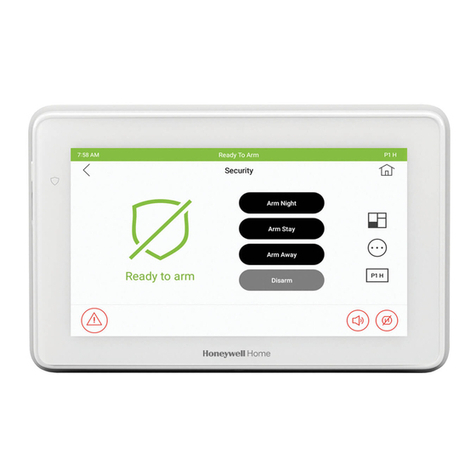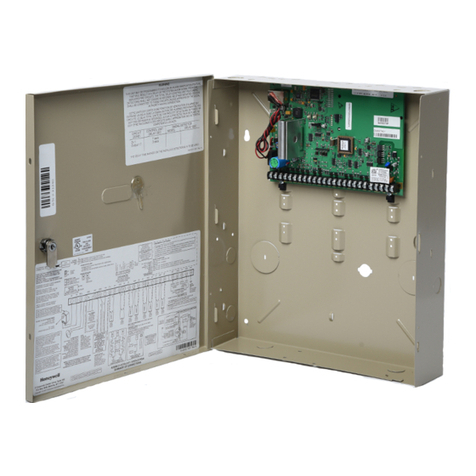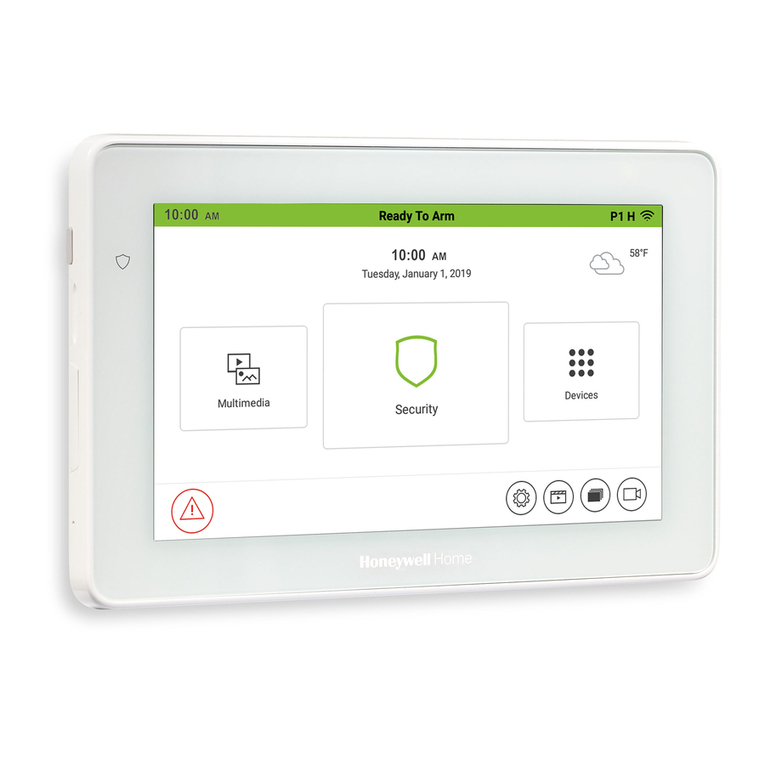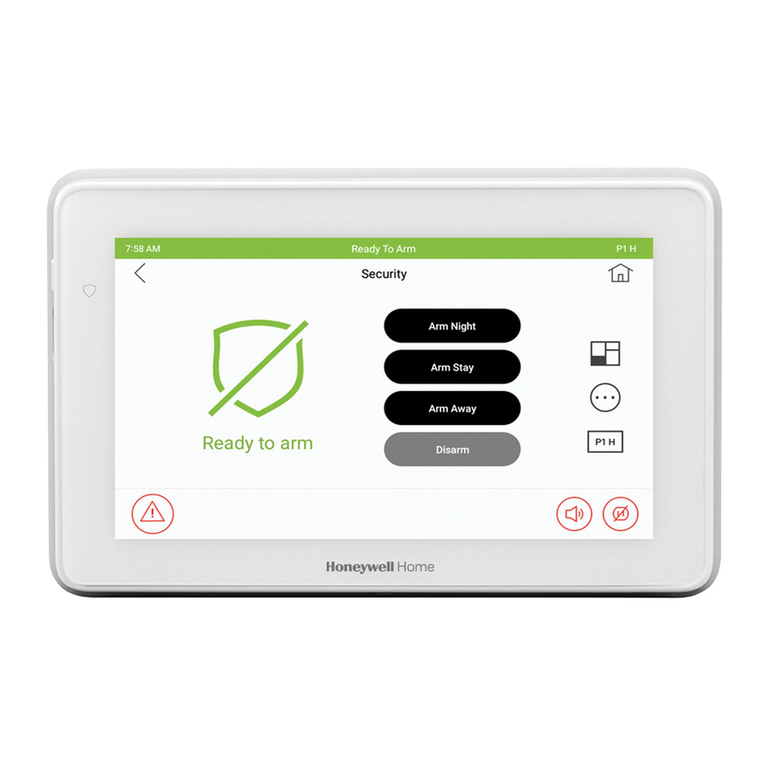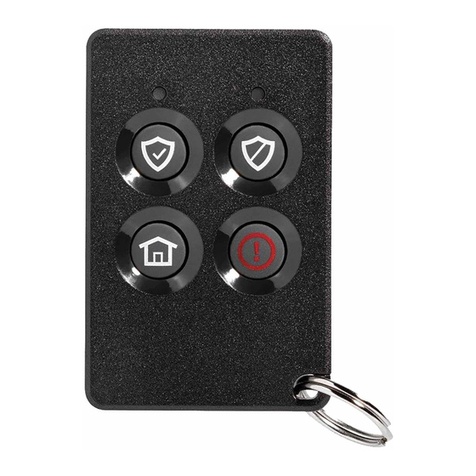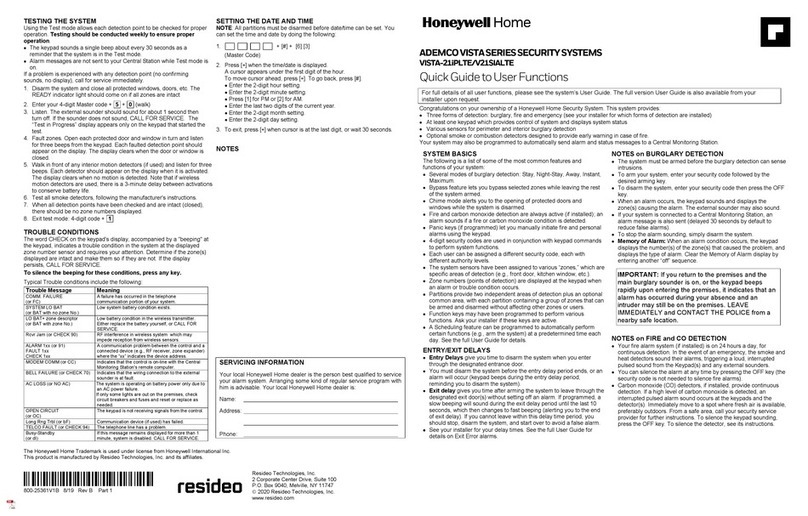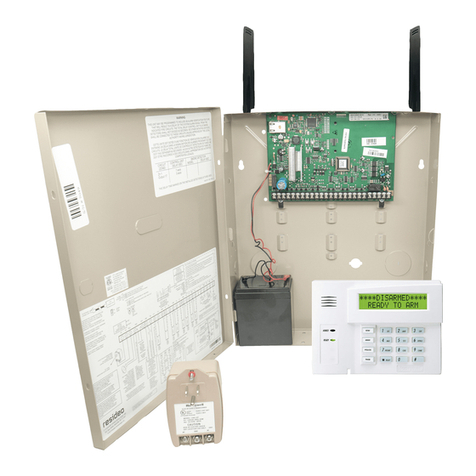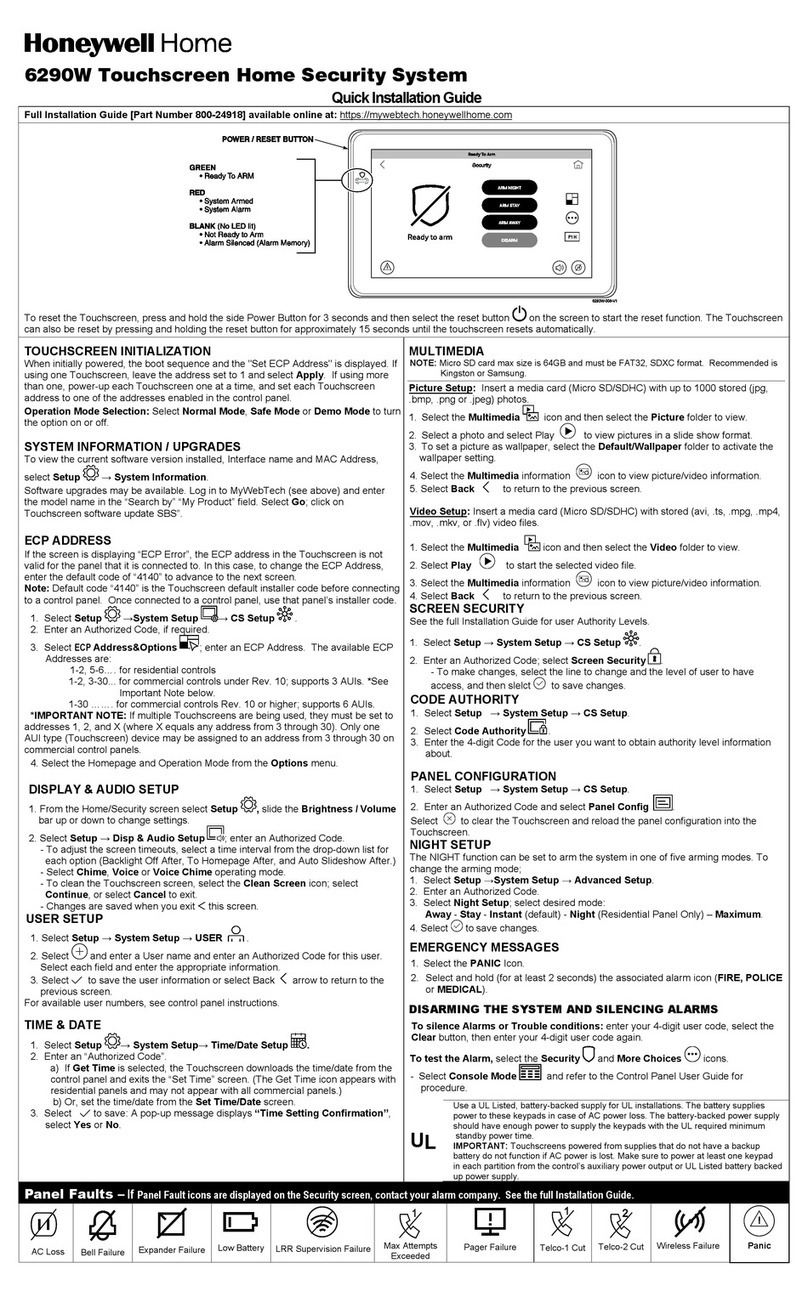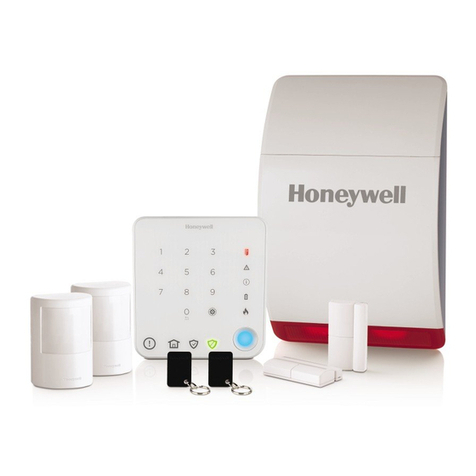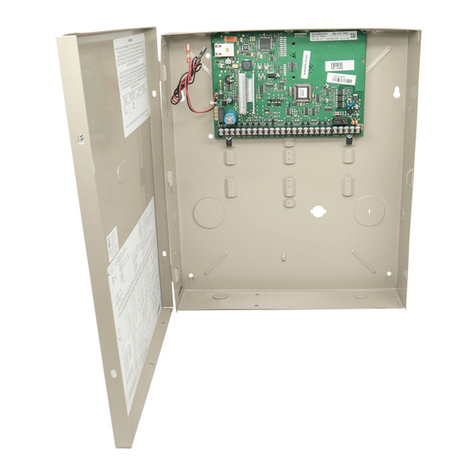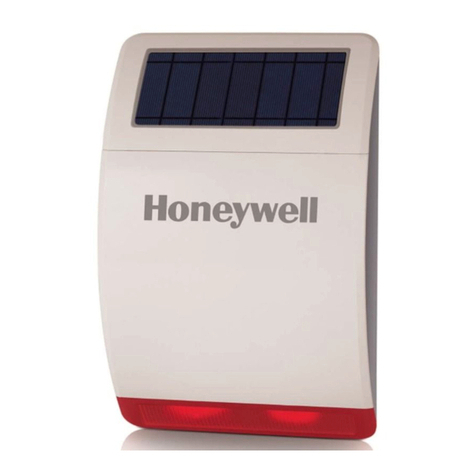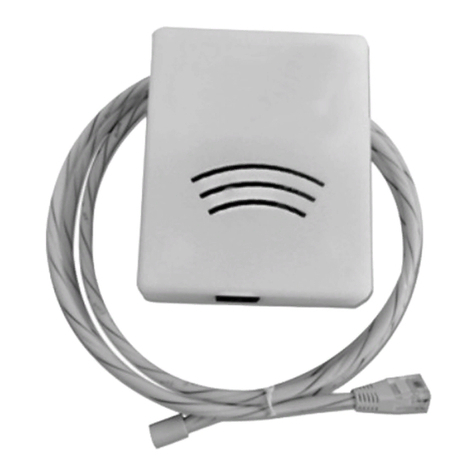
The Limitations of this Alarm System
While this system is an advanced design security system, it does not offer guaranteed protection
against burglary or fire or other emergency. Any alarm system, whether commercial or
residential, is subject to compromise or failure to warn for a variety of reasons. For example:
•Intruders may gain access through unprotected openings or have the technical sophistication
to bypass an alarm sensor or disconnect an alarm warning device.
•Intrusion detectors (e.g., passive infrared detectors), smoke detectors, and many other
sensing devices will not work without power. Battery-operated devices will not work without
batteries, with dead batteries, or if the batteries are not put in properly. Devices powered
solely by AC will not work if their AC power supply is cut off for any reason, however briefly.
•Signals sent by wireless transmitters may be blocked or reflected by metal before they reach
the alarm receiver. Even if the signal path has been recently checked during a weekly test,
blockage can occur if a metal object is moved into the path.
•A user may not be able to reach a panic or emergency button quickly enough.
•While smoke detectors have played a key role in reducing residential fire deaths in the United
States, they may not activate or provide early warning for a variety of reasons in as many as
35% of all fires, according to data published by the Federal Emergency Management Agency.
Some of the reasons smoke detectors used in conjunction with this System may not work are
as follows. Smoke detectors may have been improperly installed and positioned. Smoke
detectors may not sense fires that start where smoke cannot reach the detectors, such as in
chimneys, in walls, or roofs, or on the other side of closed doors. Smoke detectors also may
not sense a fire on another level of a residence or building. A second-floor detector, for
example, may not sense a first-floor or basement fire. Moreover, smoke detectors have
sensing limitations. No smoke detector can sense every kind of fire every time. In general,
detectors may not always warn about fires caused by carelessness and safety hazards like
smoking in bed, violent explosions, escaping gas, improper storage of flammable materials,
overloaded electrical circuits, children playing with matches, or arson. Depending upon the
nature of the fire and/or the locations of the smoke detectors, the detector, even if it operates
as anticipated, may not provide sufficient warning to allow all occupants to escape in time to
prevent injury or death
•Passive Infrared Motion Detectors can only detect intrusion within the designed ranges as
diagrammed in their installation manual. Passive Infrared Detectors do not provide volumetric
area protection. They do create multiple beams of protection, and intrusion can only be
detected in unobstructed areas covered by those beams. They cannot detect motion or
intrusion that takes place behind walls, ceilings, floors, closed doors, glass partitions, glass
doors, or windows. Mechanical tampering, masking, painting or spraying of any material on
the mirrors, windows or any part of the optical system can reduce their detection ability.
Passive Infrared Detectors sense changes in temperature; however, as the ambient
temperature of protected area approaches the temperature range of 90° to 105°F, the
detection performance can decrease.
•Alarm warning devices such as sirens, bells, or horns may not alert people or wake up
sleepers if they are located on the other side of closed or partly open doors. If warning
devices sound on a different level of the residence from the bedrooms, then they are less
likely to waken or alert people inside the bedrooms. Even persons who are awake may not
hear the warning if the alarm is muffled from a stereo, radio, air conditioner or other appliance,
or by passing traffic. Finally, alarm warning devices, however loud, may not warn hearing-
impaired people or waken deep sleepers.
•Even if the system responds to the emergency as intended, however, occupants may have
insufficient time to protect themselves from the emergency situation. In the case of a
monitored alarm system, authorities may not respond appropriately.
•This equipment, like other electrical devices, is subject to component failure. Even though this
equipment is designed to last as long as 10 years, the electronic components could fail at any
time.
The most common cause of an alarm system not functioning when an intrusion or fire occurs is
inadequate maintenance. This alarm system should be tested weekly to make sure all sensors
and transmitters are working properly.
Installing an alarm system may make one eligible for lower insurance rates, but an alarm system
is not a substitute for insurance. Homeowners, property owners, and renters should continue to
act prudently in protecting themselves and continue to insure their lives and property.
We continue to develop new and improved protection devices. Users of alarm systems owe it to
themselves and their loved ones to learn about these developments.
RF Exposure
Warning –
The antenna(s) used for this device must be installed to provide a separation
distance of at least 7.8 inches (20 cm) from all persons and must not be co-located or operating
in conjunction with any other antenna or transmitter except in accordance with FCC and ISED
multi-transmitter product procedures.
Mise en Garde
Exposition aux Frequences Radio:
La/les antenne(s) utilisée(s) pour cet émetteur
doit/doivent être installée(s) à une distance de séparation d'au moins 20 cm (7,8 pouces) de
toute personne et ne pas être située(s) ni fonctionner parallèlement à tout autre transmetteur ou
antenne, excepté en conformité avec les procédures de produit multi transmetteur FCC et
ISEDs.
This equipment should be installed in accordance with National Electrical Code, NFPA 70,
Standard for the Installation of Residential Fire Warning Systems, CAN/ULC-S540 and
Chapter 2 of the National Fire Alarm Code, ANSI/NFPA 72 (National Fire Protection
Association, Batterymarch Park, Quincy, MA 02269). Printed information describing proper
installation, operation, testing, maintenance, evacuation planning, and repair service is to
be provided with this equipment.
Warning: Owner’s instruction notice: ’Not to be removed by anyone except occupant
Avertissement : Avis du propriétaire : « Ne doit être retiré par personne, saut
l’occupant. »
Warning: this unit includes an alarm verification feature that will result in a delay of the
system alarm signal from the indicated circuits. The total delay (control unit plus smoke
detectors) shall not exceed 60 seconds. No other smoke detector shall be connected to
these circuits unless approved by the local authority having jurisdiction.
Avertissement: Cette unité peut être programmée pour utiliser une fonction de vérification
d’alarme d’incendie qui entraîne un délai dans la signalisation des alarmes provenant des
circuits dédiés à l’incendie. Le délai total (unité de commande et détecteurs de fumée) ne
doit pas dépasser 60 secondes. Aucun autre détecteur de fumée ne doit être raccordé à
ces circuits sans l’approbation des autorités compétentes locales.
Note Each protected circuit within this control is supervised
.
SUPPORT & WARRANTY
See Installation and Setup Guide P/N 800-25082 or higher.
For the latest documentation and online support information, please go to:
www.resideo.com
For the latest warranty information, please go to:
www.security.honeywellhome.com/warranty
Recommendations for Proper Protection
The Following Recommendations for the Location of Fire and Burglary Detection Devices Help
Provide Proper Coverage for the Protected Premises.
Recommendations for Smoke and Heat Detectors
With regard to the number and placement of smoke/heat detectors, we subscribe to the
recommendations contained in the National Fire Protection Association's (NFPA) Standard #72
noted below.
Early warning fire detection is best achieved by the installation of fire detection equipment in all
rooms and areas of the household as follows: For minimum protection a smoke detector should
be installed outside of each separate sleeping area, and on each additional floor of a multi-floor
family living unit, including basements. The installation of smoke detectors in kitchens, attics
(finished or unfinished), or in garages is not normally recommended.
For additional protection the NFPA recommends that you install heat or smoke detectors in the
living room, dining room, bedroom(s), kitchen, hallway(s), attic, furnace room, utility and storage
rooms, basements and attached garages.
In addition, we recommend the following:
•Install a smoke detector inside every bedroom where a smoker sleeps.
•Install a smoke detector inside every bedroom where someone sleeps with the door partly
or completely closed. Smoke could be blocked by the closed door. Also, an alarm in the
hallway outside may not wake up the sleeper if the door is closed.
•Install a smoke detector inside bedrooms where electrical appliances (such as portable
heaters, air conditioners or humidifiers) are used.
•Install smoke detectors at both ends if the hallway is more than 40 feet (12 meters) long.
•Install smoke detectors in any room where an alarm control is located, or in any room
where alarm control connections to an AC source or phone lines are made. If detectors are
not so located, a fire within the room could prevent the control from reporting a fire or an
intrusion.
This Control Complies with NFPA Requirements for Temporal Pulse
Sounding of Fire Notification Appliances
Recommendations for Proper Intrusion Protection
•For proper intrusion coverage, sensors should be located at every possible point of entry to
a home or premises. This would include any skylights that may be present, and the upper
windows in a multi-level building.
•In addition, we recommend that radio backup be used in a security system. This will ensure
that alarm signals can be sent to the alarm monitoring station in the event that the
communications are out of order (if connected to an alarm monitoring station).
DINING
KITCHEN BEDROOM
BEDROOM
BEDROOM
BEDROOM
LIVING ROOM BEDROOM
BDRM
DINING
LIVING ROOM
TV ROOM KITCHEN
BEDROOM BEDROOM
TO
BR
LVNG RM
BASEMENT
KTCHN
.
CLOSED
DOOR
GARAGE
Smoke Detectors for Minimum Protection
Smoke Detectors for Additional Protection
Heat-Activated Detectors
BDRM
floor_plan-001-V1
Federal Communications Commission & ISED Statements
The user shall not make any changes or modifications to the equipment unless authorized by
the Installation Instructions or User's Manual. Unauthorized changes or modifications could
void the user's authority to operate the equipment.
CLASS B DIGITAL DEVICE STATEMENT
This equipment has been tested to FCC requirements and has been found acceptable for use.
The FCC requires the following statement for your information:
This equipment generates and uses radio frequency energy and if not installed and used
properly, that is, in strict accordance with the manufacturer's instructions, may cause
interference to radio and television reception. It has been type tested and found to comply with
the limits for a Class B computing device in accordance with the specifications in Part 15 of
FCC Rules, which are designed to provide reasonable protection against such interference in a
residential installation. However, there is no guarantee that interference will not occur in a
particular installation. If this equipment does cause interference to radio or television reception,
which can be determined by turning the equipment off and on, the user is encouraged to try to
correct the interference by one or more of the following measures:
• If using an indoor antenna, replace it with a quality outdoor antenna.
• Reorient the receiving antenna until interference is reduced or eliminated.
• Move the radio or television receiver away from the receiver/control.
• Move the antenna leads away from any wire runs to the receiver/control.
• Plug the receiver/control into a different outlet so that it and the radio or television receiver
are on different branch circuits.
• Consult the dealer or an experienced radio/TV technician for help.
ISED CLASS B STATEMENT
This Class B digital apparatus complies with Canadian ICES-003.
Cet appareil numérique de la classe B est conforme à la norme NMB-003 du Canada.
FCC / ISED STATEMENT
This device complies with Part 15 of the FCC Rules, and ISED’s license-exempt RSSs.
Operation is subject to the following two conditions: (1) This device may not cause harmful
interference, and (2) This device must accept any interference received, including interference
that may cause undesired operation.
Cet appareil est conforme à la partie 15 des règles de la FCC et exempt de licence RSS ISED.
Son fonctionnement est soumis aux conditions suivantes: (1) Cet appareil ne doit pas causer
d’interférences nuisibles. (2) Cet appareil doit accepter toute interférence reçue y compris les
interférences causant une réception indésirable.
Responsible Party / Issuer of Supplier’s Declaration of Conformity: Ademco Inc., a subsidiary of
Resideo Technologies, Inc., 2 Corporate Center Dr., Melville, NY 11747, Ph: 516-577-2000
The product should not be disposed of with other household waste. Check for the nearest
authorized collection centers or authorized recyclers. The correct disposal of end-of-life
equipment will help prevent potential negative consequences for the environment and human
health.
The Honeywell Home Trademark is used under license from Honeywell International
Inc. This product manufactured by Resideo Technologies, Inc. and its affiliates.
Resideo Technologies, Inc
2 Corporate Center Drive, Suite 100
P.O. Box 9040, Melville, NY 11747
© 2020 Resideo Technologies, Inc. All rights reserved.
Ê800
Ê800Ê800
Ê800-
--
-25079fŠ
25079fŠ25079fŠ
25079fŠ
800-25079B 3/19 Rev. B

